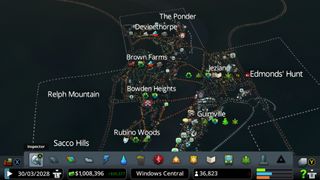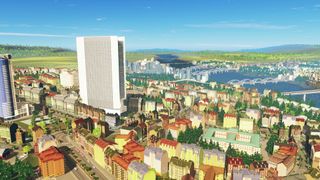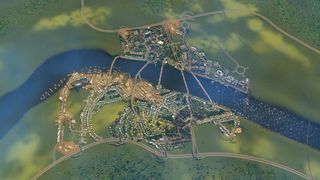Cities: Skylines for Xbox One review — The best management game money can buy
There aren't many management games on Xbox One, due to the lack of mouse support. Cities: Skylines completely sidesteps this issue, delivering the best city management game in a generation.



Management games, such as SimCity, Theme Park, or Planet Coaster, are often very complex. Not only are you micro-managing the game itself, but also the various overlapping menus that govern the game. As such, the preferred input method has, historically, been mouse and keyboard.
Cities: Skylines has proven that controllers can be a worthy input method for this type of game.
Most of us already know Cities: Skylines is a tremendous game. It has set the standard for city-building games for years to come, as EA famously flubbed SimCity's 2013 version, forcing users to participate in an awful online experience that would go on to kill the franchise almost entirely.
Regardless of Cities: Skylines' success on PC, that doesn't necessarily mean it would be great on Xbox One. Those huge, sprawling 3D cities can get extremely complex and hardware intensive, and that's without discussing control schemes. Of course, you won't have a mouse while playing Skylines on Xbox One.
However, I am overjoyed to report that Cities: Skylines has proven that controllers can be a worthy input method for this type of game. Tantalus, Colossal Order, and Paradox Interactive have thoroughly nailed Cities: Skylines on Xbox One, making it one of this generation's must-play console titles.
Building a city
Cities: Skylines is widely regarded as one of the best urban-construction and management games of the modern era. While EA set about turning SimCity into an online service, Colossal Order was hard at work trying to recapture the classic essence of the genre with Cities: Skylines, and its predecessors, Cities in Motion 1 and 2.
Cities: Skylines focuses a little more heavily on infrastructure and services instead of micro-managing buildings. In Cities, you designate areas for commerce, residency, or industry, ensuring that nearby roads have good access to nearby freeways and that buildings are adequately stocked with power and water.
Get the Windows Central Newsletter
All the latest news, reviews, and guides for Windows and Xbox diehards.

Figuring out how to place your water, power sources, and infrastructure forms the game's initial challenge. I thought I'd be clever and place the sewage works far away from my water works to avoid contamination, but getting piping across a large area was too expensive at the start of the game, forcing me to rethink a little.
If you let it, Cities: Skylines could take over your life.
Those early challenges I faced pale in comparison to the masses of complexity that layer themselves onto the game as you progress.
Later on, you'll manage the needs of thousands of people, economic issues, emergency services, dynamic traffic systems, imports and exports, public transport routes, and much more. There's a dizzying complement of activities to undertake in Cities: Skylines, making it viciously addictive. If you let it, Cities: Skylines could take over your life — at least for a while.

My main gripe with Cities: Skylines is that you're a little restricted by the way the game's zoning systems work. For example, industrial zones get polluted and noisy, and the way to combat that is to put down trees and leisure activities nearby. But when have you ever seen a factory with a tennis court outside?
Without the PC's rich modding community, or the additional expansions that have yet to make their way to console, I feel as though most players' cities could end up following similar patterns. Every area needs a hospital, police station and a fire station. Every map has specialized resources, so you'll likely see farms, oil plants, and wind farms on the same locations in each individual player's games.


That said, there are plenty of opportunities to modify your city's style through taxation, planning policies, and other systems that promote certain types of industries over others. It often makes sense to turn a beachfront into a tourist attraction, or a riverfront into a cool night spot, but you might also have to manage things such as increased crime, pollution, and increased traffic.
The game appears straightforward at first, but there are plenty of nuances hidden away that don't seem obvious. For example, I was attempting to make use of a large area of fertile land, only to find that for some reason, my farm plots weren't able to find enough workers to staff them. I built lots of high-density accommodation to lure workers to the area, but reading the tooltip, you'll discover that those sorts of apartments are favored by young adults, who are seeking higher education and office jobs rather than manual labor.

I could have modified the district to favor work over education, but in the end I decided the best course of action was to destroy all the local schools, forcing everyone into a life of farming. Over time, my area became flooded with avid farmhands, filling my city's coffers with delicious cash from their exports. Or at least, I think that's what happened. It's a little hard to tell.
My finances look good, so I must be doing something right ... I think?
Indeed, that's the only real criticism I can leverage at Cities: Skylines. Sometimes it's simply hard to tell whether your "strategies" are working, or whether it's the result of a series of divine accidents.
I have no idea why my oil refineries aren't receiving new shipments of fuel, despite being placed right next to the freeway. I have no idea why, despite having hospitals right next door to sick patients with a maxed-out health budget, people are still dying of illnesses. There are also various icons that aren't explained in-game, even when you use the inspection tool.
My city, tentatively dubbed "Windows Central," has a lot of abandoned industries, shops that need customers, and dead people, but hey, my finances look good, so I must be doing something right ... I think?

Either way, there's a voyeuristic glee about being in command of your very own city. Zooming in on any house or building will give you a glimpse at the detail Colossal and Tantalus have reproduced for the Cities: Skylines version on Xbox One. Little firemen jump out to hose down burning buildings, teenagers congregate outside their respective high schools, and you'll often see people traveling to work, grabbing a bite to eat or walking the dog.
Using the inspection tool, you can select and follow the game's citizens around on their daily routines, and even examine their happiness, employment status, and more. Sure, there's not a great deal of gameplay relevance when it comes to examining your thousands of inhabitants close up, but it's the attention to detail that makes Cities: Skylines utterly engrossing.

Bottom line: Cities: Skylines is tremendously fun, and if you were a fan of the classic SimCity-type games, you'll feel right at home here.
But how does it work on Xbox One?
This is the real kicker, and it's something I've been asked fairly frequently since we checked out the game at GDC 2017. Having spent an extensive amount of time with Cities: Skylines, I think it represents the best switch to controller for a game of this type, maybe ever.
The game uses every button on the Xbox One controller harmoniously. You move the camera using the joysticks, zooming in and out using the triggers, and the game makes use of various toggles for performing different actions. Pressing X gives you the demolition menu, while A is your global select button. B is to cancel, and the D-pad serves as navigation across the game's various menus. Holding down the Y button produces a radial menu for various functions, such as different types of road painting, and a quick-jump menu for viewing city information.



At any time, you can hit the right stick to view more in-depth information about any building, button, or service. And a tap of the left stick will halt the flow of time, allowing you to micro-manage at your leisure.
Using the joystick as your "cursor" works immensely well most of the time. It can be a little tricky to snap it correctly to certain objects, particularly if you have a metro station underground, on top of some road, and then a bridge on top of that. Learning to master the cursor might take time, but once you have it down, it's incredibly easy to use. Making sure the camera is located directly overhead helps a great deal when attempting to delete layered objects, coupled with the zoom for added precision.

The real beauty is the consistency. Shoulder buttons always navigate left and right between menus. Holding Y always opens a radial menu. X is always for demolition. Cities: Skylines sidesteps the pitfalls that other games with complex controls often fall into, which sometimes forces you to learn multiple contexts per button. Skylines keeps it simple and intuitive.
Tantalus and Colossal did a wonderful job making Cities: Skylines playable on a controller, and it should serve as an example for other developers of mouse-heavy games looking to bring their work to consoles.
So, how's the performance?
Cities: Skylines allows you to produce impossibly large settlements, with tens of thousands of individual inhabitants, thousands of vehicles, and dynamic systems for transit, utilities, and beyond. Even on a fairly capable PC, Cities: Skylines can chug as the complexity ramps up, and the same is true on Xbox One.
I played Cities: Skylines for fifteen hours as of writing, and not once did the game freeze, crash, or glitch out — even as my city grew to more than 35,000 inhabitants. However, the game utilizes an unlocked frame rate, which can crash down when zoomed in.

Cities: Skylines uses a lot of tricks to keep itself ticking on Xbox One. Buildings will drop resolution rapidly as you move the camera, which exemplifies the careful consideration Tantalus offered while making the game's tradeoffs.
It's only when viewing your city up close that you will notice decreased performance, and it never hinders play.
When the game drops below 30 frames per second (FPS), it's only the 3D aspects of the game that lose performance. The UI itself remains responsive, and when you select an object for building, the game cleverly switches to a blueprint-like mode that removes the textures from buildings to give you maximum performance. It's only when viewing your city up close that you will notice decreased performance, and it never hinders play.
Cities: Skylines is a relatively passive game, and while lost frames might be frustrating in an online multiplayer game, I'm confident most people will adjust happily to Cities: Skyline's unlocked frame rate.
Final thoughts on Cities: Skylines for Xbox One
Cities: Skylines is already highly regarded on PC for its lovingly detailed simulation gameplay. Few modern city-building games approach Skylines in terms of quality and depth, and it's awesome to see a smaller developer step in and prove that there's still an audience for this type of game, even if the big players weren't willing to provide it.

When it comes to the Xbox One version, I'm quite happy to say that Cities: Skylines already resides among my favorite games on the console, and I'm eagerly awaiting the arrival of the rest of the game's DLC that's currently available on PC.
I am resoundingly impressed with how well the control schemes have translated to a controller, and it gives me hope that we could one day see more complex management-type games hit Xbox One, now that Cities: Skylines has shown us the way forward.
Pros:
- Mercilessly fun and rewarding.
- Industry-leading building simulation.
- Incredible attention to detail.
- Intuitive gamepad controls.
Cons:
- Frame rate can suffer when zoomed in.
- It's not always clear why you're losing money or citizens.
- It's so addictive that it will ruin your relationships and productivity.
If you fancy yourself the town mayor of a sprawling metropolis of your own design, pick up Cities: Skylines. Just keep an eye on the clock, or you might find that you lost an entire day to this wildly addictive game.
Cities: Skylines is expected to launch on Xbox One on April 21st, 2017 for $39.99.
We reviewed Cities: Skylines on Xbox One using a code provided by Paradox Interactive.

Jez Corden is the Executive Editor at Windows Central, focusing primarily on all things Xbox and gaming. Jez is known for breaking exclusive news and analysis as relates to the Microsoft ecosystem while being powered by tea. Follow on Twitter (X) and Threads, and listen to his XB2 Podcast, all about, you guessed it, Xbox!